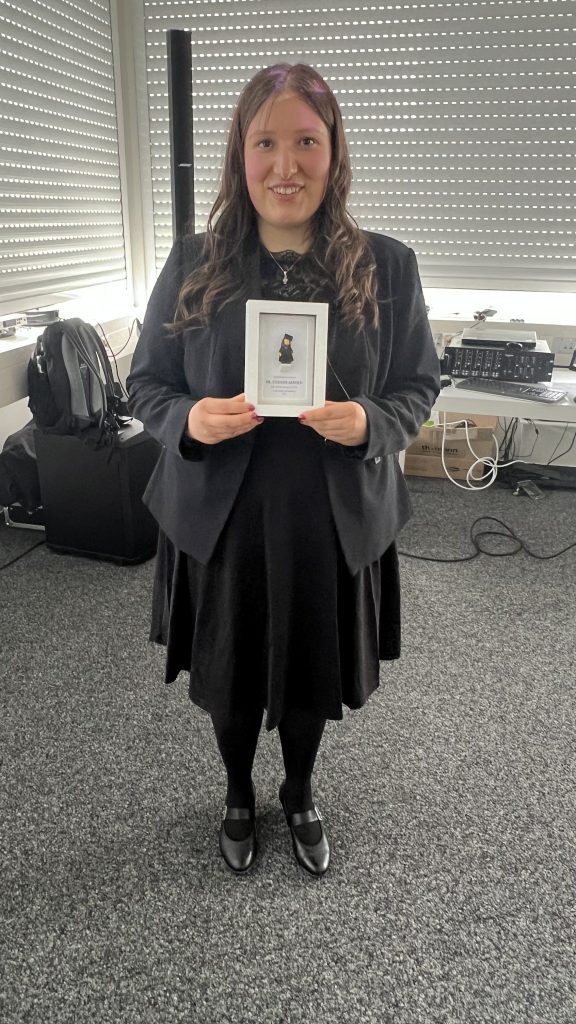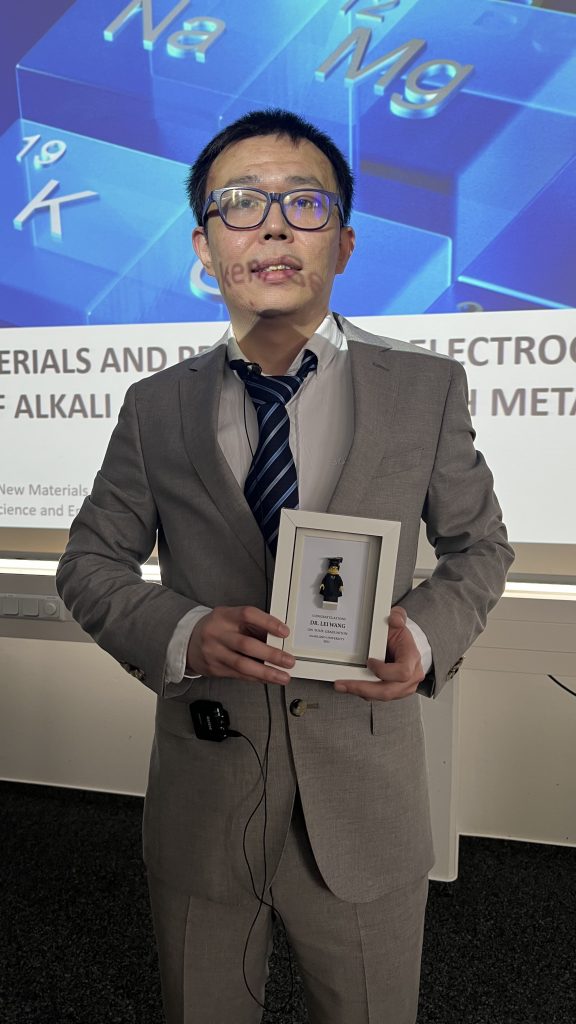New paper published in Small on Cu/V-Organophosphonates. In this collaborative work, we report a layered redox-active, antiferromagnetic metal organic semiconductor crystals with the chemical formula [Cu(H2O)2V(µ-O)(PPA)2] (where PPA is phenylphosphonate).
New paper published on hydrogel-based flexible energy storage in Advanced Materials Interfaces. Our study showcases a novel electrolyte system that stands out due to its flexibility, electroactivity, and improved sustainability.
We initiated our research by electropolymerizing polypyrrole (PPy) nanotubes in graphite-thread electrodes, utilizing methyl orange templates in an acidic medium. This process successfully enhanced the conductivity, while maintaining the flexibility of the electrodes, a crucial component in developing versatile energy storage systems. We built flexible devices using hydrogel as an electrolyte prepared from poly(vinyl alcohol) (PVA)/sodium alginate (SA). This hydrogel was obtained through freeze-thawing and swelling with ionic solutions. The result was a homogenous and porous hydrogel matrix, demonstrating high conductivity of 3.6 mS/cm as-prepared and the ability of self-healing.
What sets this material apart is its adaptability. The material’s electrochemical and mechanical properties depend on the swollen electrolyte used, allowing its integration with the modified graphite-thread electrodes. This flexibility led us to develop a quasi-solid electrochemical energy storage device, with a specific capacitance value of 66 F/g at 0.5 A/g. The choice of less environmentally friendly acid electrolyte HNO3 yielded a higher capacitance in the range of 100 F/g. These attributes relied on the liquid phase in the hydrogel matrix produced from biodegradable polymers.
We thank our collaborators who were instrumental in this research project. Special acknowledgment to our esteemed colleagues from the Departamento de Química, Universidade Federal do Paraná in Brazil: Andrei Elias Deller, Izabel C. Riegel-Vidotti, and Marcio Vidotti. On our team, we are grateful for the contributions of Ph.D. student Jean Gustavo De Andrade Ruthes, our postdoc and Humboldt-Fellow Emmanuel Pameté.
Volker Presser gives an online seminar with the title “Electrochemical Lithium-Ion Extraction” at DIFFER (Dutch Institute for Fundamental Energy Research).
The progressing electrification of water remediation: review article on electrosorption of organic compounds in Chemical Engineering Journal.
I am happy to see now-online our latest review paper, which summarizes the science and technology of electrosorption of organic compounds (EOC). Traditional methods of water treatment, such as adsorption, encounter limitations when it comes to effectively removing ionic and hydrophilic organic contaminants. Moreover, the lack of on-site regeneration techniques further hinders the efficiency of these methods. EOC not only enhances the adsorption performance but also enables green electricity-assisted regeneration of the adsorbent.
Over the past decades, the field of EOC has witnessed exponential growth in research studies. Many examples demonstrate that the application of electrical potentials can remarkably enhance the adsorption affinity, capacity, and kinetics of conductive carbon adsorbents. However, it remains unclear whether these effects are specific to certain compound classes or universally applicable, and the optimal criteria for designing EOC processes remain elusive.
In our research, we conducted a critical evaluation of the current state of the art in EOC, with a primary focus on active control of adsorption and desorption processes and their effects on both ionic and neutral organic compounds. By thoroughly considering compound speciation and surface chemistry of electrode materials, we gained mechanistic insights into the EOC process and highlighted the differences between electrosorption of inorganic and organic compounds.
We have also proposed insightful performance parameters and provided clear definitions to unify the rapidly expanding research in the EOC field. By doing so, we aim to establish a foundation for consistent analysis and evaluation of EOC techniques. Furthermore, we discuss potential application scenarios and outline future research directions to guide the development of this exciting technology. EOS, thereby, is not a one-size-fits-all solution for removing contaminants. However, it offers a valuable tool, particularly for tackling the challenges posed by hydrophilic and ionic organic contaminants, which often prove difficult for conventional adsorption processes.
Thanks to the great team of scientists authoring the work from the Helmholtz Centre for Environmental Research (UFZ): Navid Saeidi, Falk Harnisch, Franz-Dieter Kopinke, Anett Georgi
We are very happy that Delvina Tarimo (PhD) has been awarded a research fellowship by the Alexander von Humboldt Foundation! Delvina will be carrying out work on nanoconfinement and lithium-sulfur batteries. Congratulations, Delvina, and thanks for choosing the INM-Leibniz Institute for New Materials and our team for your research!

Work of our group has been presented at the 6th International Conference on Battery Deionization & Electrochemical Separation (BDI&E 2023). Former group member, Prof. Choonsoo Kim, presented joint work on “Redox-mediated Electrodialysis for Valorization of Tetramethylammonium hydroxide (TMAH) from Semiconductor Wastewater”. Volker Presser gave an online talk on “Continuous and intermittent direct electrochemical lithium extraction”.
Stefanie Arnold has successfully defended her Ph.D. thesis “Next generation (hybrid) battery materials at the water/energy/recycling nexus”. Congratulations, Dr. Arnold!

Jean Ruthes and Volker Presser present at the 2nd Franco-German Summer Workshop on High Power Devices in Nantes (France).
Volker speaks about “MXene and hybrid electrodes for high performance energy storage” on the 21st of June.
Jean speaks about “Hydrogel-based flexible energy storage using electrodes based on polypyrrole and carbon threads” on the 23rd of June.
Volker Presser gives an online talk entitled “Electrochemical Desalination” as part of the Nanohubs Program of the Department of Science and Technology in the Philippines within the Theme “Empowering Young Filipino Researchers for an Emerging Technology Ready Philippines”.
New work published in Carbon in collaboration with Prof. Choonsoo Kim. In our research, we explore the impact of different carbon types on desalination capacity and rate. We exemplify the impact of conventional carbon black, nanoscaled carbon onions, and micro-mesoporous carbons. In the early cycles, we observed that using AC electrodes without additives resulted in a higher desalination capacity, reaching approximately 10 mg/g. However, there was a trade-off: the desalination rate was slightly lower. It turns out that larger AC particles limited the transportation of ions within the electrode due to the increased diffusion path length.
By incorporating small and less porous additives, we achieved the highest desalination rate (20 μg/g/s) as the additive particles reduced the ion diffusion path length by increasing size dispersion, thus enhancing overall ion transport and desalination rates.
Welcome new Postdoc Jian Zhou, who will be working on electrochemical desalination with us.
Expanding the 2D flatlands: toward MBene Li- and Na-ion batteries 🔋
In our ongoing research to identify sustainable technological alternatives 🌱, we have explored the potential of layered boride materials (MoAlB and Mo2AlB2) for their use in Lithium-ion and Sodium-ion batteries (LIBs and SIBs) 🔬. Great to see our Open Access paper now appeared in print in Small Methods! 🖨️
Some key findings from the paper include:
👉Unlike MXene, no HF is needed for the 3D-to-2D etching reaction🧪
👉Sodium hydroxide treatment applied to MoAlB results in a porous morphology 🍯, leading to higher specific capacities than its original form
👉Mo2AlB2 showcases a more promising specific capacity compared to MoAlB for LIBs, registering a specific capacity of 593 mAh/g after 500 cycles at 200 mA/g ⚡
👉When it comes to SIBs, Mo2AlB2 demonstrated a specific capacity of 150 mA/g at 20 mA/g 📊.
These findings underscore the potential of layered borides as an interesting electrode materials for both LIBs and SIBs, and illuminate 🔦 the significance of surface redox reactions in Li storage mechanisms.
A sincere thank you 🙏 to our amazing partners for their invaluable contributions and collaboration.
Tulane University:
Ahmad Majed
Chukwudi Nwaokorie
Karamullah Eisawi
Audrey Buck
Matthew Montemore
Michael Naguib
INM-Leibniz Institute for New Materials:
Mohammad Torkamanzadeh
Volker Presser
Berkeley Lab:
Chaochao Dun
Jeff Urban
New paper published in a special issue of Energy Technology on battery research ontology. This work offers a logical framework that seamlessly integrates with digital architecture, enabling efficient visualization, correlation, and prediction capabilities in battery production, research, and development.
The ontology employs a predetermined terminology to specify materials and processes, establishing a chain of unit processes that connect raw materials to the final products of battery cell production. Moreover, it facilitates the attachment of analytical methods, known as characterization methods, to the relevant items. To ensure its suitability for both industrial-scale and laboratory-scale data generation and implementation, extensive workshops and interviews with battery materials and production process experts were conducted during its development.
The ontology encompasses the identification and definition of raw materials and intermediate products across all production steps, ultimately leading to the creation of the battery cell. Standard materials and process chains serve as the foundation for defining steps and items using commonly used terms. Furthermore, the research explores alternative structures and the integration of the ontology with existing ontologies.
New review paper published in Industrial Chemistry & Materials on utilizing the electrochemical quartz crystal microbalance (EQCM) to better understand the charge/discharge processes in supercapacitors.
Supercapacitors are renowned for their exceptional attributes, including high power density, fast charging capabilities, and remarkable cycling stability. To further enhance their potential, it is crucial to comprehend the intricacies of their charging processes. The EQCM, with its nanogram-level in situ mass change information, has played a pivotal role in unraveling these mechanisms.
Our paper provides a comprehensive review of the progress made in EQCM, covering theoretical fundamentals and its applications in supercapacitors. We also delve into the fundamental effects of ion desolvation and transport, shedding light on their impact on supercapacitor performance.
By thoroughly examining the advantages and limitations of EQCM in supercapacitors, we present a holistic view of this groundbreaking technique. Moreover, we propose future directions for further exploration in this dynamic field.
This work was done in collaboration with our long-time collaborator Guang Feng from the Interface and Transport Phenomena (ITP) Laboratory at Huazhong University of Science and Technology (HUST).
Lei Wang has successfully defended his Ph.D. thesis “Faradaic materials and processes for the electrochemical separation of alkali and alkaline earth metal ions”. Congratulations, Dr. Wang!

New paper published in Advanced Materials Interfaces on mechanisms in high-performance tin oxide / MXene batteries. As the demand for power and energy storage continues to grow, we researchers are constantly exploring new ways to improve battery performance. One promising approach involves using conversion/alloying materials, such as tin oxide, to design high-performance lithium-ion batteries. While these materials show excellent performance and ease of preparation, they often suffer from mechanical instabilities during cycling that limits their usefulness. This issue can be addressed (and overcome) by combining tin oxide with MXene.
In this study, we prepared a 50/50 (by mass) tin oxide / Ti-MXene (SnO2/Ti3C2Tz) nanocomposite and optimized it as a negative electrode for lithium-ion batteries. The result? A nanocomposite that delivers over 500 mAh/g for 700 cycles at 0.1 A/g and demonstrates excellent rate capability, with 340 mAh/g at 8 A/g.
The success of this nanocomposite lies in the synergistic behavior of its two components, which we confirmed through ex situ chemical, structural, and morphological analyses. Not only does this knowledge allow us to formulate a reaction mechanism with lithium-ions that provides partial reversibility of the conversion reaction, but it also opens up new possibilities for designing high-performance lithium-ion batteries.
Thanks to our great team of collaborators:
Team Ricerca sul Sistema Energetico – RSE SpA & Università degli Studi di Milano-Bicocca:
Antonio Gentile
Chiara Ferrara
Stefano Marchionna
Riccardo Ruffo
Team INM-Leibniz Institute for New Materials:
Stefanie Arnold
Volker Presser
Team Karlsruhe Institute of Technology (KIT)
Yushu Tang
Julia Maibach
Christian Kübel
New paper published in Applied Catalysis B: Environmental which explores a promising new approach to resource recovery and wastewater treatment. Nitrate is widely distributed in industrial wastewater and contaminated water bodies, and electrochemically converting it into ammonia holds great potential. At the same time, the treatment of harmful algal blooms (HABs) presents a significant challenge worldwide. It’s time-consuming, resource-intensive, and has a high CO2 footprint. But what if we could see this carbon and nitrogen-rich biomass as a vast renewable resource, rather than disposable waste? That’s precisely what we set out to do.
Within our Sino-German collaboration, we developed a Fe-dispersed carbon-based catalyst derived from HABs biomass. The resulting material achieved a maximum ammonia yield rate of 16449 μg/h/cm2 (1.2 mmol/h/mg_cat) and NH3 Faradaic efficiency of 87.3%. Furthermore, the catalyst demonstrated excellent stability, with continuous operation over 50 hours. Our experimental and theoretical calculation results suggest that the Fe-N4 site facilitates the electrocatalytic nitrate reduction reaction by reducing the energy barriers of the NO3–-to-NH3 pathway.
We believe our strategy of upcycling HABs biomass waste into functional catalysts represents a significant step forward in renewable and carbon-neutral energy technologies. We are grateful for the opportunity to contribute to this field and are excited to continue exploring new solutions to some of our most pressing environmental challenges.
This work was a collaboration with our Chinese colleagues from Jiangnan University (He Wang, Shuaishuai Man 满帅帅, Han Wang, Qun Yan) and Jiangsu Hongqi Biotechnology (Yong Zhang).
New paper published in npj Materials Degradation (open access). In cooperation with the group of Frank Mücklich at Saarland University and partners, we have found that coating laser-patterned stainless-steel surfaces with carbon nanotubes (CNT) or carbon onions (CO) can create an effective solid lubrication system. By storing the particles inside the pattern, lubricant retention is improved and depletion in the contact area is prevented. In previous works, we used laser interference patterning to create line patterns with different depths and coated them with CNTs or COs. Friction tests were conducted to study the effect of structural depth on the lubricity of these surfaces, and we found that shallower textures result in lower friction coefficients. Our latest study examines the degradation of the carbon nanoparticles on substrates with different structural depths, and Raman characterization shows severe degradation of both particle types. This degradation is classified within Ferrari’s three-stage amorphization model. Electron microscopy also confirms that CNT lubricity is improved at the cost of increasing particle defectivity, while CO-derived tribofilms experience even more substantial structural degradation.
Welcome new postdoc Dr. Gracita Tomboc! With past experience at Myongji University, Korea University, and Université du Québec à Trois-Rivières, we are excited about our upcoming joint work on energy and electrochemistry.
Welcome new AMASE Students Peter Burger and Maria Holmström! AMASE is an international Master’s program and an amazing opportunity to study not just materials science but to do so in multiple European cities! Both will be working on novel materials and methods for electrochemical desalination. Welcome to the team!
